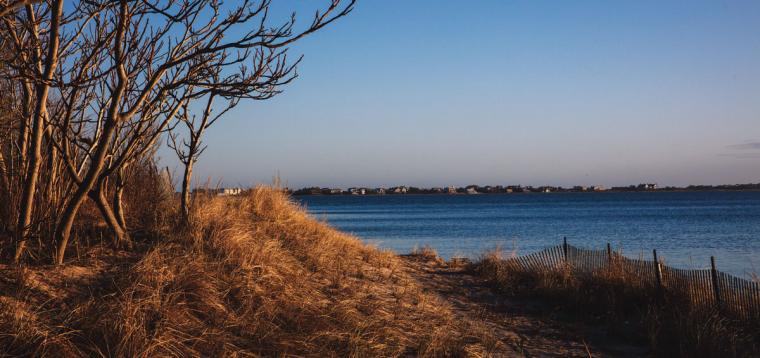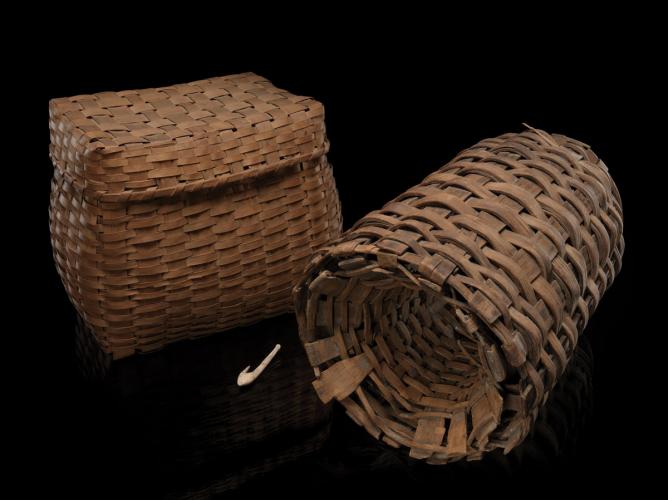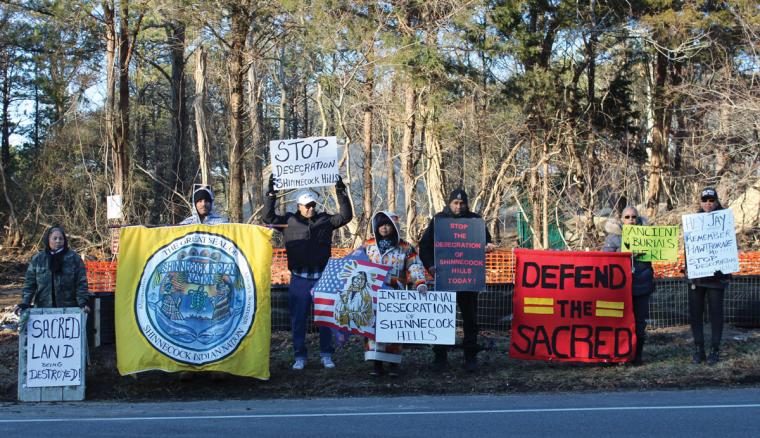As COVID-19 ravaged communities across the world during the past year, many affluent New York families sought safe haven in places like the Hamptons, Long Island’s famed oceanfront retreat for the rich and famous. Roughly 100 miles east of midtown Manhattan, the Hamptons form a seaside paradise, where seagulls wheel over grand estates, multimillion-dollar mansions and chic boutiques, gliding on breezes that cool its string of upscale hamlets and villages such as Southampton, the first permanent English settlement in New York.
Just 2 miles west—yet a world away—is the home of the Shinnecock, American Indians whose ancestral roots on the island long predate the arrival of Europeans in 1640. Since then, the Shinnecock people have endured land grabs, population loss, poverty, marginalization and other threats to their existence from colonialism and later from lack of employment opportunities. Yet they have managed to retain about 900 acres, a portion of their original territory and one of only two Long Island tribes to do so. The Unkechaug Nation, a state-recognized tribe located on the Poospatuck Reservation less than 50 miles further west, also retained some of their homelands. Today, the Shinnecock are confidently asserting their rights as members of a sovereign tribal nation.
Shrunken Territory
The Shinnecock Indian Nation has approximately 1,550 enrolled members, of whom roughly half live on Shinnecock Neck, a peninsula that juts into Shinnecock Bay on the South Fork of Long Island. The Neck, plus approximately 80-acres in the nearby hamlet of Hampton Bays, is the heart of the Shinnecock tribe, the key to their history and cultural identity. “Everything that we do—our songs, our prayers, our dances, our sense of relationship to one another, our sense of community—all revolves around our connection to this land . . . and to the water that surrounds us,” says tribal member Aiyana Smith. “When I think about my Indigenous roots, . . . it’s really my relationship to the land and the people that hold this land in common.”
“The Shinnecocks have owned their own lands since time immemorial and have never left,” says Lance Gumbs, vice chairman, Shinnecock Indian Nation Council. “We have never been removed from our land and placed in what most people know as a reservation.” However, he says, the Shinnecock territory has “shrunk through the theft of lands over the years.” Before Europeans arrived, the Shinnecock people occupied a 146-mile ancestral territory, which included oceanfront, bays, sounds, marshes, creeks, salt meadows, forests and grasslands. The Shinnecock world began to change in 1640, when village leaders permitted English colonists to share a portion of their lands in exchange for 60 cloth coats, 60 bushels of corn and the promise of military protection. The Englishmen considered the agreement a land sale, memorializing it in a “deed” that transferred to themselves a swath of Indigenous territory upon which they established Southampton. The land appropriation continued in 1703, when the nation relinquished territory to Southampton in return for a 1,000-year lease of 3,500 acres. This included the Shinnecock Hills, now home of the ultra-exclusive Shinnecock Hills Golf Club. And in 1859, the New York Legislature approved a shady deal that abrogated the 1703 lease, returned the Shinnecock Hills to Southampton and restored Shinnecock Neck to the tribe. The transaction, long considered fraudulent by the Shinnecock, reduced the tribe’s land base to its present size.
Increasingly bereft of land, Shinnecock tribal members were forced to find employment in the colonial economy. Women became domestic servants in non-Native households, and men worked as farm laborers and as whalers who harvested their quarry close to shore. Later, Shinnecock men made the transition to deep-sea whaling, joining crews that spent most of the year aboard vessels plying far-flung oceans. As the whaling industry declined in the late 19th century, Shinnecock men found work on salvage crews recovering cargo from ships that foundered off the coast of Long Island. In December 1876, 10 Shinnecock men died aboard the Circassian, a freighter that had in stormy seas run aground off the coast of Mecox Bay in Bridgehampton. The Hamptons’ emergence as a resort destination in the late 1800s opened new employment opportunities for Shinnecock men to work as hunting and fishing guides, golf caddies and chauffeurs. Women worked as cooks and maids for wealthy families and sold handmade baskets to tourists eager to acquire souvenirs. Today, employment opportunities in the Shinnecock community are scarce, and many tribal members must commute to jobs elsewhere on Long Island and in the greater New York metropolitan area.
A Tidal Wave of Change
In spite of four centuries of challenges, the Shinnecock have managed to remain on their homelands. But this place has been changing, often from external forces. In recent decades, the Hamptons, particularly Southampton, have seen an invasion of billionaires—Wall Street tycoons, Hollywood moguls, pop stars and assorted glitterati, many of whom are building multimillion-dollar homes and estates at a pace that is overwhelming their environment. The area has become “a playground for the very elite rich,” says tribal member Autumn Rose Williams. “There’s really a big dichotomy between the haves and the have-nots here.”
The Shinnecock can see the class divide from their doorsteps. Looking east across Shinnecock Bay, bulldozers raze homes that will be replaced by megamansions built for the richest 1 percent. Across Heady Creek from the Neck is Meadow Lane, also known locally as “Billionaire Lane,” where a home sold for $41 million in 2018. A five-minute car ride brings you to Cooper’s Neck Lane, which Zillow ranked the eighth richest street in the United States.
The luxury property boom has been a boon for real estate moguls, and it could provide a windfall to the Shinnecock residents were they to sell some of their coveted land. But “selling the land is not gonna happen,” insists Shinnecock tribal member Lauryn Randall. “Not in my lifetime, and I’m going make sure that my children know that’s not something that we do.” That seems to be the consensus on the Neck.
With a ringside seat to unbridled development, the Shinnecock people see how construction and population growth pollute their water resources and diminish shellfish habitat. Increased nitrogen runoff from fertilizers used in lawn care and effluents from faulty septic systems in particular have sullied area waterways. Growing up, Aiyana Smith recalls how she and her fellow tribal members spent summers digging for clams and harvesting oysters, scallops and other seafood, a way of life for generations of Shinnecocks. Beginning in the 1980s, “I started to see the change in the environment and pretty soon there were no more scallops,” she says. Then she started to see fewer and fewer oysters and mussels. “The shellfish that used to sustain us just isn’t in the water anymore.”
That conclusion is shared by scientists at Stony Brook University, who in 2012 founded the Shinnecock Bay Restoration Program to document and reverse the bay’s deteriorating water quality. The program has been planting clams and seeding new eelgrass beds to help increase water filtration in the bay. This helps reduce nitrogen levels and algae blooms, which improves water quality and strengthens fish and shellfish habitat. But restoring fish and shellfish habitat is a slow and expensive process, made more difficult by the breakneck speed of nearby development. Meanwhile, more frequent storms and rising water levels are threatening to erode the Shinnecock shoreline—a problem the nation’s environmental department is trying to address by dredging sand, planting sea and beach grasses and creating a reef of oyster shells to reduce the waves’ power.
While they have struggled to preserve their shorelines, the Shinnecock have recently experienced some success in protecting ancient unmarked burial sites from desecration by construction crews. For years, builders plowed up Shinnecock human remains and cultural objects Finally, in September 2020, the Shinnecock Nation persuaded Southampton authorities to impose a six-month moratorium on new construction in areas believed to be ancestral burial sites and to establish protocols for encountering human remains at other sites. Last fall, the Shinnecocks and their supporters also held a rally to halt construction at Canoe Place, a historic heritage site where developers are building residential housing. Some units there will rent for $8,000 a month.
Bold, Bright Statements
Despite the economic gap between those who live in the Hamptons and Long Island’s original residents, the Shinnecock say their grievances are not resulting from a conflict between rich and poor but rather their struggle for tribal sovereignty. This was finally affirmed in 2010, when the Shinnecock Nation was officially recognized by the federal government as a self-governing tribe.
Today, the exercise of Shinnecock sovereignty is perhaps best reflected in recent tribal efforts to erect highway billboards as well as open a gaming facility on Shinnecock land – economic development initiatives that have sparked opposition from area residents and New York State. The conflict around billboards began nearly two years ago, when the Shinnecock Nation began building one of two 61-foot, electronic advertising displays along both sides of Sunrise Highway. The rectangular towers are crowned by the official seal of the Shinnecock Indian Nation. Below, brightly lit digital panels display technicolor advertisements for local businesses, high-end consumer goods as well as public-service messages, including in spring 2020 government advisories relating to COVID-19 health and safety protocols.
Shinnecock leaders hope ad revenue will provide much-needed funding to create on-reservation jobs as well as subsidize tribal social programs. More than generating revenue, however, these monuments, as the Shinnecock refer to the billboards, are powerful symbols of Indigenous sovereignty and community pride, reminders to motorists and area residents that they are on Shinnecock land. But for some residents of Southampton, the billboards are a towering lapse of taste that sully the Hamptons’ upscale vibe. The New York State Department of Transportation also took umbrage, issuing a stop-work order on the first billboard and filing a lawsuit in 2019 to halt construction of the second. The state alleged that the Shinnecock Nation failed to seek a building permit, that the billboards posed a potential public safety risk and, significantly, that the billboards are on nontribal land.
The Shinnecock Nation disputes all of these claims, especially that the billboards are not on their land. “This is the last remaining piece [of land] that we never lost, that never changed hands—that wasn’t stolen,” Gumbs asserted in 2019. And because the Shinnecock Nation is self-governing, he says, the state lacks authority to determine the monuments’ fate. Gumbs is hardly alone in that assessment. Last fall, a group of Shinnecock activists and local allies called the “Warriors of the Sunrise” set up a roadside encampment called “Sovereignty Camp 2020” to protest the state’s actions and educate passersby about the nation’s grievances and sovereign rights. The protest attracted considerable media attention as well as support from non-Native organizations and individuals, including Southampton resident and rock legend Roger Waters, co-founder of the band Pink Floyd.
The billboard conflict continues. In January 2021, New York State issued a stop-work order on the second, unfinished billboard, notifying the tribe that it would face a $2,000-a-day fine should work continue. If the nation failed to comply, the state warned, the billboard might be removed. The warning failed to weaken the Shinnecocks’ resolve. “We will never stand down for our right to use our land for the betterment of our people and future generations,” Gumbs asserted.” Construction of the second monument was completed in February.
That month, the Shinnecock Indian Nation also unveiled plans for developing another potential engine of economic development: a 76,000-square-foot gaming facility on tribal land. The establishment, the first of its kind in the Hamptons, will include a bingo parlor, 1,000 video-lottery terminals and 30 Texas hold‘em table games. Construction is expected to begin this summer, pending approval of an environmental impact study, and would take about 12 to 14 months to complete. As with the billboards, the Shinnecock people hope gaming will help their Nation become more self-sustaining by providing much-needed jobs as well as revenue to finance social programs. Additionally, they say, gaming would diversify a reservation economy limited to smoke shops, convenience stores and the annual Shinnecock Powwow, a critical 74-year-old tradition and source of income that was closed to visitors in 2020 because of COVID-19.
Southampton Town officials look askance at the Shinnecock’s quest to promote economic development through gaming. They worry that a casino will increase traffic on an already congested artery, that more vehicles will generate more noise and more pollution. “This is not economic development I can support,” Town Supervisor Jay Schneiderman told a local television reporter. “It would be hard to find a worse property to locate a gaming facility.”
The Shinnecock people have heard this before. But the days of buckling under pressure from powerful neighbors are over. “We’re not just gonna be the stepchildren of the Hamptons anymore,” Gumbs says. “Every single time that we’ve tried to do something for self-preservation in terms of economic development, . . . we’ve been stopped with these roadblocks.” Now, he says, “We’re no longer going to be barked at and just bow down to the individuals who think that we’re this people who are just going to take it.”






